If the purpose of a research paper is to try and answer more questions than it raises… I may have failed.
The White farthing token has told us just about all that we know concerning W. L. White. He operated Halifax House, a dry goods business, in Halifax, Nova Scotia. The piece has been shrouded in mystery, as to what date that it would have been issued, and nothing is known about its issuer, W. L. White or Halifax House. There are two varieties: the one that we occasionally see, and the one that we only hear about. In the first variety the “D” of DRY is to the left of the “C” of CHEAP, and in the rare second example the “D” of DRY is directly under the “C” of CHEAP.
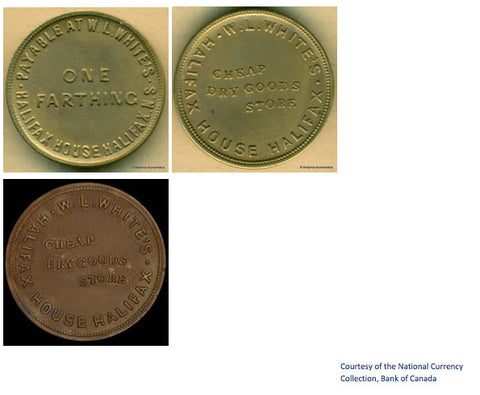
All of the latter 19th Century and early 20th Century numismatic researchers assigned one or more numbers to the piece. It is known as Breton #899, Courteau #362-363NS, Leroux #454, McLachlan 323, Atkins #4, and more recently as Willy #349-350, and Charlton #NS-17A1, and NS-17A2. The difficulty in researching Mr White, is that he is not from a prominent Halifax merchant family such as William Black, or a fiery politician/merchant such as John Alexander Barry, nor is he related to Miles W. White and his Shelburne family, all of whom have had volumes written about them. The shipping records do not reveal his name, nor is there any trace of W. L. White in the birth, wedding, or death certificates. The history of the elusive Mr. White has been gleaned from going through the newspapers, and by piecing everything together.
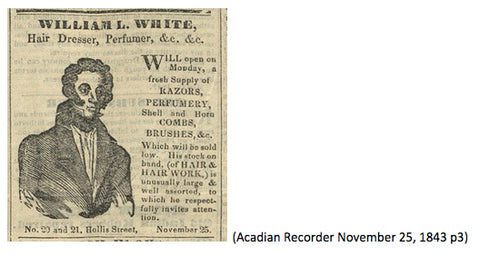
William L. White opened his business as a hairdresser and perfumer on Monday, November 27th, 1843, at 20 & 21 Hollis Street in Halifax. The advertisement was informative as it states the date that the ad was first published, and reveals that he would have been opening the following Monday. It further gives us the nature of his business, and apparently shows his image, which was unusual for the time. Missing from the advertisement is any mention about Halifax House. The advertisement ran in the Acadian Recorder up until February 3rd, 1844. No other advertisements appear for William L White, up until the White & Donohoe series commenced on October 5th, 1844
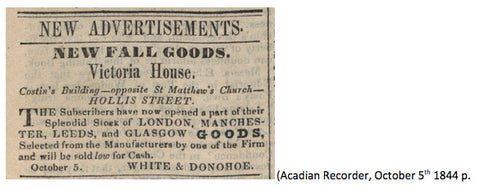
This advertisement shows them with a selection of British and Scottish goods, but with the name Victoria House. From the advertisement it is difficult to determine if this is William L. White, along with his partner, either Patrick or James Donohoe, who were other merchants, operating around the same time. Fortunately for token collectors, Mr. Donohoe got himself into a bit of trouble, and their connection is given courtesy of the London Gazette of April 26, 1850, as follows.
following prisoners whose estates and effects have been vested in the provisional assignee by order of court for relief debtors petitions schedules duly filed severally referred transmitted to county courts mentioned pursuant statute that behalf are ordered be brought up judges said respectively herein set forth dealt with according law judge lancashire holden at lancaster on friday day may eleven o forenoon precisely donohoe formerly residing water-street afterwards spring-gardens same time occupying a shop no. hollis-street all halifax province nova scotia british north america part carrying business co partnership william lawrence white aforesaid as merchants under firm merchant his separate account late islington liverpool
London Gazette, n.d. Web. 2013. <www.london-gazette.co.uk>
From this we learn of their partnership and that W. L. White, is in fact William Lawrence White. Regarding his personal life, little is known, other than they were both Irish or of Irish descent, as they and many others from the large Halifax Irish community were instrumental in forming an Association to assist for the continuing relief of their suffering countrymen. Over the next several years it was business as usual for White & Donohoe operating as Victoria House as evidenced by a series of advertisements.
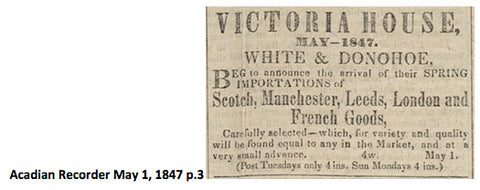
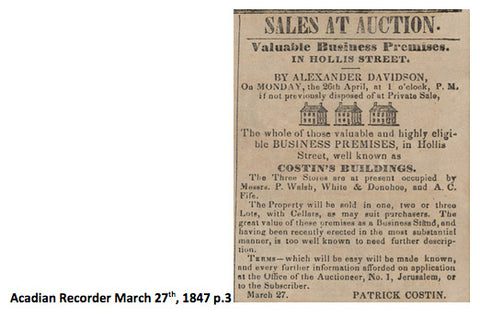
Their last regular ad appeared in the Acadian recorder, May 1st 1847, where they were offering their usual selection of Scottish, English and French dry goods. What might suggest a possible future change in their business arrangement was a March 27th, 1847 advertisement in the same paper. Their business premises, known as Costin’s Building, was being offered for sale at public auction on April 26th, 1847. The next advertisement for the partners was June 5th, 1847 where they advertised that they were selling off their inventory, and that their co-partnership would cease on the 13th of July.
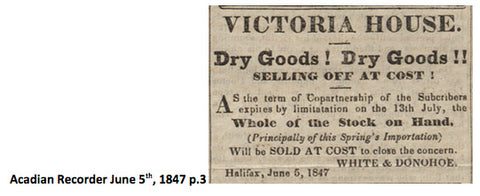
Donohoe continued doing business under the name Victoria House; his brush with the law had been short-lived. Advertisements for his business continue up until Dec 18th, 1856. From the previously cited London Gazette, we already know that by 1850 Donohoe would also have had business interests in Liverpool, England.
The announcement that William Lawrence White was going to soon be opening Halifax House at 145 Granville Street appeared in the Acadian Recorder on October 16th, 1847, and again on the 23rd and 30th. This was the new prime commercial row that was now rivaling Water Street.
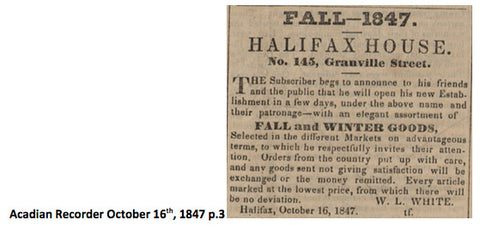
Herein lies the dilemma; after the initial announcement of a soon-to-open business there is no mention of W. L. White or Halifax House. Not in the Acadian Recorder, nor in the Halifax British Colonist. The next reference to 145 Granville Street is not until October 16th, 1851, when Samuel Strong, formerly doing business with W. J. Coleman, announced the opening of his business at that address.
What can be said with reasonable certainty is that the W. L. White farthing was issued in 1847. The rest is conjecture, but it would appear that Halifax House was either short lived, or never opened. Pierre Napoleon Breton, in his 1894 publication, Illustrated History Of The Coins And Tokens Relating to Canada, mentions that, “The Coin was considered very rare having sold as high as ten dollars, but a large number have recently been found, and its price has fallen accordingly”. To have a valuation like that in the 1890s would suggest that White’s farthing would not have been in circulation, as most are found in better than average condition, which would suggest a hoard of un-issued pieces. Also to be considered is that White was a prolific advertiser, and to go from being well documented through the advertisements to no mention of him and Halifax House would further suggest that the business never opened. Joseph Leroux in 1888 gave a comparable rarity rating of 6 to that of the New Brunswick and Nova Scotia Success token (Breton #895), and the White farthing. The impact of the hoard is shown by Eugene Courteau in 1910. The “Success” token maintains a rarity rating of 6, while the W. L. White token has the decreased rarity rating of 5. The numismatic publication that was closest to being a contemporary of the token was Alfred Sandham’s 1869 publication, “Coins, Tokens and Medals of the Dominion of Canada”. The White farthing is not mentioned, possibly because it had not been in circulation, and was therefore unknown. In The Charlton Token Catalogue they reference that there are two varieties and apparently cast counterfeits. It is possible to hypothesise that the rare variety would have been sent to White for approval, and was rejected with White wanting a design that was more visually balanced. The design was not in common usage; the reverse side was like many other Irish merchant issued farthings, but the obverse with its curved lettering was almost unknown. The only other farthing with the distinctive lettering was that of Michael Hennessey from Galway Ireland. The date of issue is unknown, but in Paul & Bente Withers, “The Token Book 2 – Unofficial Farthings And their Values 1820 – 1901” there is a note that Michael Hennessy was not to be found in the 1824 or 1846 Irish Directories. Given the similarity of design the tokens are probably contemporaries of one another, but unfortunately the manufacturer is not known. As for the cast counterfeits, these may have possibly been some late 19th century jiggery-pokery, it was after all fetching up to ten dollars.
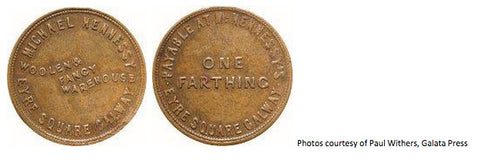
Why would anybody issue a farthing? The farthing was practically an unknown denomination. There had been the Trade and Navigation pieces, but apart from that, there were not any other farthing tokens circulating in Nova Scotia. It probably was not a shortage of coinage. There had been shortages in the early 1830s, but the Nova Scotia government’s unofficially issued Thistle tokens alleviated much of the problem. This was a complete contrast to the British experience in merchant issued farthings, as their abundance was due to a shortage of change. R. C. Bell in his book, ‘Unofficial Farthings 1820 – 1870’, suggests that the euphonistically termed “Advertisement Tickets”, be better named “Unofficial Farthings”, since their issuers were prepared to receive them in change as a farthing. In White’s case, despite the denomination, they may or may not have been intended as change, but they probably were intended for use as an advertising ticket.
Bibliography:
“Coins Tokens And Medals Of The Dominion Of Canada”, Alfred Sandham, 1869
“Illustrated History Of The Coins And Tokens Relating to Canada”, P. Napoleon Breton, 1894
“Money and Exchange In Canada to 1900”, A. B. McCullough, Dundurn Press, 1984
“The Canadian Coin Cabinet”, Joseph Leroux, 1888
“The Coins And Tokens Of The Possessions Of The British Empire”, James Atkins, 1889
“The Coins And Tokens Of Nova Scotia”, Eugene G. Courteau, 1910
“The Token Book 2, Unofficial Farthings and their Values 1820 – 1901, Paul & Bente Withers, Galata Press, 2013
“Unofficial Farthings 1820 – 1870”, R. C. Bell, Seaby Publications Ltd, 1975
